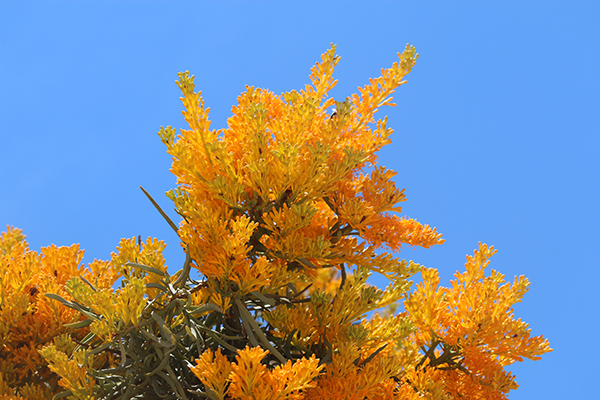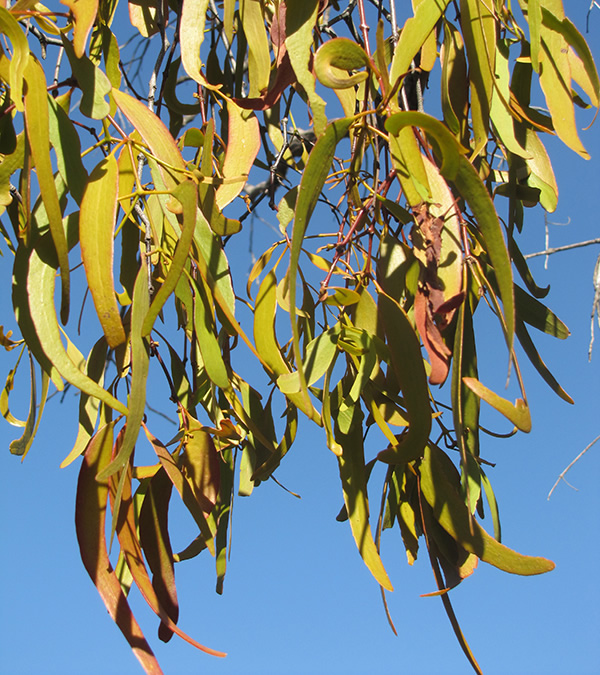Most people are familiar with seeing images of traditional mistletoe during the festive season, and the concept of ‘kissing under the mistletoe’ at Christmas time, but less people know that we have a variety of native mistletoes in Australia and that they bring a number of benefits.

Stalked Mistletoe (Amyema miquelii) growing on a eucalypt
Mistletoes are semi-parasitic plants that attach to the stems of other trees and shrubs, drawing extra nutrients from their host. In the Avon Wheatbelt alone there are eleven officially recorded mistletoe species from the family Loranthaceae (which also includes the well-known Western Australian Christmas Tree - Nuytsia floribunda).

Western Australian Christmas Tree - Nuytsia floribunda
Stem-attaching species can often be seen as a bunch of denser vegetation hanging in tree-branches, usually in eucalypts, wattles or she-oaks. Trees may have more than one mistletoe attached to them, but unless there is a very heavy burden they tend to cope quite well with the hitchhikers. Some mistletoes even piggyback on other mistletoes already attached to the host plant.
Mistletoes are a valuable food source to birds, butterflies and other animals. They can also provide a tasty snack for humans! Because mistletoes have fairly broad flowering and fruiting seasons there are usually berries and nectar available from one species or another for most of the year.
Amyema linophylla on she-oak
The small, sweet, sticky fruits form the main diet of the Mistletoe Bird (Dicaeum hirundinaceum) which is so adapted to eating the berries that it will only live where sufficient mistletoes grow. In repayment the bird is essential in dispersing the seeds, which are dissolved in the stomach of some other animals, but which pass through the Mistletoe Bird’s system and come out still sticky, often adhering to branches the bird visits and forming new attachments from there.
Possums are known to browse on the leaves, especially if other moisture-containing leaves are scarce, and many animals target the insects attracted to mistletoes as a food source. Because they form slightly denser balls of foliage within the larger host plants, mistletoes also provide good nesting habitat for smaller birds or shelters for some arboreal mammals. The extra foliage can act as camouflage, protection and shade for nests or roosting spots. There is even evidence that they can contribute to the formation of tree hollows – something many threatened animals such as the Red-tailed Phascogale and Carnaby’s Cockatoo are in short supply of, especially in the Wheatbelt.
Wire-leaf Mistletoe (Amyema preisii) growing on wattle
On top of all of this, mistletoes are contributors to ecosystem function and soil health too as they drop more leaf litter than other plants of the equivalent size, and the litter contains higher levels of nutrients which enrich the soil where it falls.
Overall, studies have shown mistletoes to be keystone species in their given habitats, and woodlands where they are present have higher general biodiversity, higher numbers of animal species, and up to a third more bird species than woodlands without mistletoe.
The traditional hanging of mistletoe at Christmas-time was meant to meant to bring good luck to those who lived in that place, and also symbolise love and friendship (hence the kissing!). Given all the aforementioned benefits that mistletoe can bring, it seems that having some native mistletoe growing around your home or property is good luck indeed.


